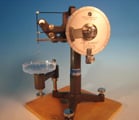Nearly every day we have a question about differences between Viscosity, Consistency and Surface Tension. There is usually a second part of the question;
“How do we correlate the measurements among these different properties?”
The simple answer is that they are different, they are measured in different ways and the measurements cannot be correlated.
The one common element is that each is an attribute of material in the liquid state. Attempts to convert measurements between these properties have resulted crushing defeat or convoluted approximation algorithms.
However each of these measurements has significant impact on formulation development, production methods and final quality of many types of products. These attributes of liquids are critical in industries as diverse as health care, food production, coatings and pharmaceuticals.
I am going to try to bring each of these liquid properties into clear perspective and show some examples of how the measurements are used in every day products.
Definitions
Viscosity, in its simplest definition, is the measure of the resistenc e of a liquid to flow. This simple definition is complicated by the realities of real liquids.
e of a liquid to flow. This simple definition is complicated by the realities of real liquids.
- Some react in rational ways and have the same resistance over wide ranges of speed.
- Some increase resistance with speed while others decrease resistance with speed
- Some change resistance simply with the passage of time.
This creates some interesting measurement challenges. About the only common characteristic is that all viscosity values change with temperature.
Consistency is an attribute that relates to firmness or thickness.
 The term is used for many materials that flow with the application of only gravitational force.
The term is used for many materials that flow with the application of only gravitational force.- Observing the extent or distance of flow over a specified time period is the principle of these measurements.
- The measurements terms are usually a derivation of time and distance and defy conversion to standard rheology terms.
Like viscosity, consistency changes with temperature.
Surface Tension, is the easiest concept to define. It is the force of attraction between molecules at the surface of a liquid. This attractive force keeps the liquid from flying off into the air and resists penetration of the surface.
- When surface tension is lowered, the liquid more easily mixes
 with other materials. For example detergent lowers water surface tension, which allows the water to penetrate clothing fibers and flush out dirt.
with other materials. For example detergent lowers water surface tension, which allows the water to penetrate clothing fibers and flush out dirt. - Watch a spider walk on water and observe the affect of surface tension. The spider’s legs do not penetrate the surface.
- Surface tension is the basic characteristic that underlies contact angle analysis. This is the interaction of a liquid with a solid surface or substrate.
This is another phenomena of a liquid that is influenced by temperature.
Each of these measurements, viscosity, consistency and surface tension share two things. Each each is property of liquids and each is affected by temperature.
Here are some example of the use of these measurements in the development and production of common products.
Industry Applications
In the coatings industry there are several product characteristics that can be defined by these liquid properties. 
- The influence of surface tension directly relates to adhesion characteristics. Adhesion is important in the development of inks and paints because they must be designed to adhere to different surfaces.
- Surface tension and related Contact Angle analysis are key the association of the coatings and inks to solid surfaces or substrates.
- Viscosity levels are critical in the development paint application methods and systems as this attribute effects flow characteristics.
Petroleum product specifications are often defined in terms of viscosity.
- An example is motor oil designation such as 10W/30 – a viscosity reference.
- Viscosity measurements and comparisons are used to monitor the deterioration of lubricating oils.
- Surface tension tests are used to detect impurities in products such as transformer oil.
Food production has a plethora of applications for these liquid attributes.
- Surface tension is a signiificant factor in the determination of mixability characteristics in applications such as selecting
 different liquid components for a salad dressing.
different liquid components for a salad dressing. - The value of viscosity measurement is in the development of products such as Ketchup formulation to get the best combination of thickness and flowability.
- The standard for process quality control of many tomato products, dressings and condiments such as mustard is a consistency-measuring device called the Bostwick Consistometer.
In the pharmaceutical world, surface tension is an important element in the efficacy or design of drug delivery systems. For example:
- Development of the most effective relations of binders, such as polymers or starches to the drug granulations in capsules
- Development of complex liquid mechanical structures that define the release conditions of new Liposomal focused drug delivery systems
- Special delivery requirements such as eye drops.
- These development activities translate into material and productions control applications where viscosity measurements are frequently the standards for quality.
Waterproofing is an example where product development relies heavily on surface tension.
 The products used for waterproofing tent fabric are based on the relationship of the size of spaces in the fabric weave and the adhesion or surface tension of raindrops.
The products used for waterproofing tent fabric are based on the relationship of the size of spaces in the fabric weave and the adhesion or surface tension of raindrops.- As those of you who are used to camping know, these fabric tents will kick off rainwater.
- However if you press your finger on a droplet it will push it through the small open spaces in the fabric.
- High Blood Pressure, High LDL, Type II Diabetes and Obesity
- High blood viscosity is a principal mechanism through which these factors convey pre-Inflamatory insult to arterial walls.
- Blood viscosity is usually measured with automated scanning viscometers base on capillary technology.
These examples only touch the surface of the places where viscosity, consistency and surface tensions measurements are important. Each of these characteristics of a liquid are individually important to the development, processing and transport of a vast variety of products. Their interrelationship, although they cannot be converted, are often critical to the formulation of acceptable and producible products.
Because of the interrelated factors of these elements it would seem logical that the measurements should be convertible from one to the other. However, there are no general correlations between Viscosity, Consistency and Surface Tension measurement.
Because we provide instruments in all three parameters, I felt it necessary to dive through my mammoth confusion and try to:
- Understand each of these liquid properties
- Illustrate their relationship to each other
- Delineate some applications that need them for product development, production management and quality control
- Deal with the question, is there a correlation? And
- Hopefully bring an understandable translation of a somewhat complex affair
I trust that this has been enlightening and useful. Please pass it long to colleauges who may find it pertinent.
I am still unnerved and mystified by this measurement business.
Art
P. S. If you would like to be informed by email of our next harangue, subscribe in the space above
Check out our Viscosity, Consistency and Surface Tension instrument offerings.
By Art Gatenby


